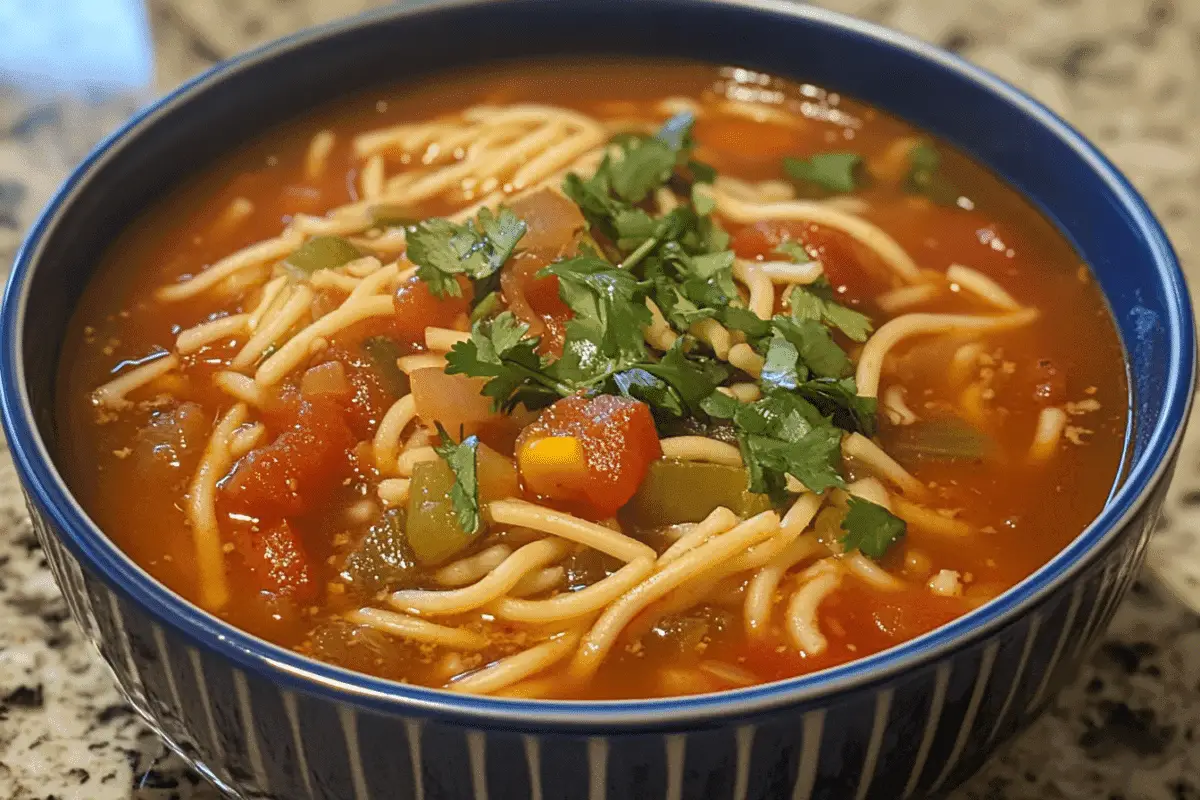
Introduction to Fideo Recipe
Fideo Recipe serves as a versatile type of pasta that has become a staple in many kitchen, especially in Mexican and Spanish dishes. This pasta resembles vermicelli but is often cut into shorter lengths, making it perfect for soups and other traditional recipes. Whether you’re aiming to create a hearty soup or a flavorful dry dish, fideo should definitely be a must have stuff in your pantry.
For those interested in expanding their pasta repertoire, you might also enjoy exploring more authentic Mexican recipes to complement your fideo dishes. Moreover, understanding the history of fideo can deepen your appreciation of this humble yet essential stuff.
The Origins and History of Fideo Recipe
The history of fideo stretches back centuries, with roots in both Spanish and Middle Eastern kitchen. The word “fideo” originates from Arabic, meaning “thread,” which reflects the thin, noodle like shape of this pasta. Over time, Spaniards adopted fideo into their cuisine, and it eventually became a cornerstone of Mexican culinary traditions. Its adaptability and ease of preparation have made it a beloved stuff across multiple cultures.
Different Types of Fideo Recipe
There are several types of Fideo Recipe, each suited to different culinary uses:
- Short Fideo: Often used in soups like Sopa de Fideo.
- Long Fideo: Similar to vermicelli, it’s perfect for dishes where a longer pasta is preferred.
- Toasted Fideo: Adds a nutty flavor to recipes and is commonly used in Fideo Seco.
Each type of fideo offers unique textures and flavors, making it a versatile stuff in both simple and complex dishes.
How to Cook Fideo Recipe
Step-by-Step Guide to Cooking Fideo Recipe
Cooking fideo is straight forward, but there are a few tips to ensure it turns out perfectly:
- Choose Your Cooking Method:
- Frying: Toasting the fideo in oil before boiling gives it a richer flavor.
- Boiling: For a lighter texture, boil the fideo in water or broth.
- Cooking Tips:
- Stir the fideo frequently to prevent sticking.
- Cook until al dente, as over cooking can lead to a mushy texture.
- Avoid Common Mistakes:
- Skipping the toasting step can result in a less flavorful dish.
- Overcrowding the pot can cause uneven cooking.
Popular Fideo Recipes
- Fideo Recipe Soup (Sopa de Fideo)One of the most traditional ways to enjoy fideo is in Sopa de Fideo, a simple yet delicious soup that combines the pasta with a tomato based broth, vegetables, and sometimes meat. Achieving the perfect balance of flavors and ensuring the fideo remains tender are key to this dish.
- Fideo Seco is a dry version of Sopa de Fideo, where the pasta absorbs all the liquid during cooking. This richly flavored dish often features toppings like avocado, cheese, and crema. As a popular comfort food in Mexico, you can easily customize it with different stuff.
- Fideo with Chicken (Fideo con Pollo) is another popular dish where you cook the pasta with chicken, vegetables, and a flavorful broth. This hearty meal perfectly suits family dinners, and you can prepare it in large batches for meal prepping.
Fideo Recipe in Global Cuisines
Fideo isn’t just limited to Mexican and Spanish kitchens. For example, it’s also a key stuff in Filipino cuisine, where it’s used in dishes like Pancit and Sotanghon. The adaptability of fideo allows it to blend seamlessly into various culinary traditions, adding texture and heartiness to a wide range of recipes
Nutritional Information and Health Benefits
- Nutritional Value of Fideo Fideo Recipe serves as a good source of carbohydrates, which provide energy. It’s also low in fat and contains essential vitamins and minerals, depending on the ingredients used in the dish. For those looking to increase the nutritional value, whole wheat fideo offers an excellent alternative.
- Health Benefits Eating Fideo Recipe can be part of a balanced diet. When you combine it with vegetables and lean proteins, it offers a nutritious meal that is both satisfying and healthy. Additionally, because it’s easy to digest, fideo is a great option for children and those with sensitive stomachs.
FAQs
Innovative Fideo Recipe Variations
Fideo Recipe offers endless opportunities for creativity in the kitchen. By incorporating unique ingredients and seasonings, you can craft dishes that stand out. Consider the following variations:
- Spicy Fideo: Add chili peppers or chipotle to your broth for a fiery twist.
- Seafood Fideo: Combine fideo with shrimp, scallops, or fish for a coastal-inspired dish.
- Fideo Primavera: Toss cooked fideo with sautéed seasonal vegetables and a light garlic sauce for a fresh and vibrant meal.
- Fideo Casserole: Layer fideo, cheese, and your favorite sauce in a baking dish, then bake until golden and bubbly.
These variations not only showcase the versatility of fideo but also allow you to tailor dishes to your personal taste preferences.
Pairing Fideo Recipe with Complementary Sides
To enhance your fideo-based meal, consider pairing it with complementary sides:
- Fresh Salads: A crisp cucumber or mixed green salad with a citrus vinaigrette balances the rich flavors of fideo.
- Grilled Vegetables: Zucchini, bell peppers, and eggplant make excellent accompaniments to fideo dishes.
- Crusty Bread: Serve with freshly baked bread or rolls to soak up any flavorful broth or sauce.
- Beans and Legumes: Black beans or lentils add protein and a hearty texture when paired with fideo.
These pairings create a well-rounded meal that satisfies a variety of taste buds and nutritional needs.
Fideo Recipe for Special Diets
With a few adjustments, fideo can accommodate various dietary preferences:
- Gluten-Free Fideo: Use gluten-free pasta to make the dish suitable for those with gluten sensitivities.
- Vegan Fideo: Swap chicken broth for vegetable stock and skip meat or dairy toppings to create a plant-based version.
- Low-Carb Fideo: Opt for spiralized vegetables or shirataki noodles as a fideo alternative for a low-carb option.
- High-Protein Fideo: Add grilled chicken, tofu, or eggs to boost the protein content of your dish.
These modifications make fideo accessible to a wider audience while preserving its delicious flavor.
The Cultural Significance of Fideo
Fideo holds a special place in the hearts of many, often evoking fond memories of home-cooked meals and family gatherings. In Mexican households, a warm bowl of sopa de fideo is a comfort food that brings families together. Similarly, in Spain, fideo is central to dishes like “fideuà,” a noodle-based paella that is celebrated during festive occasions. The cultural significance of fideo highlights its role as more than just a dish—it’s a connection to tradition and heritage.
The Science Behind Perfect Fideo
Understanding the science of cooking fideo can help you achieve the ideal texture and flavor:
- Toasting the Pasta: When you toast fideo in oil before adding liquid, the Maillard reaction enhances its nutty aroma and rich color.
- Absorption Method: Allowing fideo to absorb broth during cooking intensifies its flavor, creating a dish that’s deeply satisfying.
- Balancing Salt: Use just the right amount of salt in your broth to complement the natural taste of the pasta without overwhelming it.
These small but impactful techniques ensure that every bite of your fideo dish is perfectly balanced and flavorful.
Storing and Reheating Fideo Dishes
Proper storage and reheating techniques are essential for maintaining the quality of leftover fideo:
- Storing: Let the fideo cool to room temperature before transferring it to an airtight container.
- Reheating: Add a splash of water or broth when reheating to prevent the fideo from drying out.
These tips help you enjoy your fideo dishes just as much the second time around.
Fideo in Modern Cuisine
Chefs and home cooks alike have embraced fideo as a canvas for culinary innovation. It’s featured in fusion recipes like Asian-inspired fideo stir-fries, where traditional flavors meet modern techniques. Restaurants have also elevated fideo by incorporating it into gourmet menus, pairing it with luxury ingredients like truffle oil, lobster, or saffron. This evolution demonstrates the enduring appeal of fideo in both traditional and contemporary cuisine.
Seasonal Fideo Recipes
Take advantage of seasonal produce to create fresh and flavorful fideo dishes throughout the year:
- Spring Fideo: Pair fideo with asparagus, peas, and fresh herbs like mint or parsley.
- Summer Fideo: Add ripe tomatoes, zucchini, and a drizzle of olive oil for a light, summery meal.
- Autumn Fideo: Incorporate roasted squash, mushrooms, and sage for a cozy dish.
- Winter Fideo: Use hearty ingredients like root vegetables, kale, and spicy sausage for a warming, comforting recipe.
These seasonal variations allow you to enjoy fideo all year long, with flavors that align with the changing seasons.
Exploring Fideo Through Global Lenses
Beyond its Mexican and Spanish roots, fideo has found its way into other global cuisines:
- Middle Eastern Influence: Fideo resembles vermicelli used in dishes like “seviya” in Indian and Pakistani cuisine.
- Italian Connection: Similar to angel hair pasta, fideo can be used in Italian recipes such as light broths or seafood pasta dishes.
- Latin American Adaptations: Fideo has inspired regional variations across Latin America, including dishes that incorporate local spices and ingredients.
Exploring these global connections enriches your appreciation for the versatility and cultural significance of fideo.
Conclusion and Final Thoughts
In conclusion, fideo is a versatile ingredient that you can use in a variety of dishes, from hearty soups to dry pasta dishes. By experimenting with different types of fideo and cooking methods, you can discover new flavors and textures that will elevate your culinary skills. Whether you’re new to fideo or a seasoned cook, this ingredient is sure to become a staple in your kitchen.
For more recipes and tips, you can explore the full collection at Tati Tasty Recipes.
